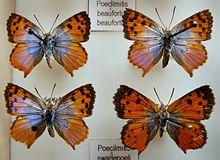| Swanepoel's opal | |
|---|---|
 | |
| Scientific classification | |
| Kingdom: | Animalia |
| Phylum: | Arthropoda |
| Class: | Insecta |
| Order: | Lepidoptera |
| Family: | Lycaenidae |
| Genus: | Chrysoritis |
| Species: | C. swanepoeli |
| Binomial name | |
| Chrysoritis swanepoeli (Dickson, 1965) | |
| Synonyms | |
| |
Chrysoritis swanepoeli, the Swanepoel's opal, is a species of butterfly in the family Lycaenidae. It is endemic to South Africa, where it is found in the Swartberg Pass and Schoemanskloof, the Groot Swartberg, the Huis River Pass and Gamkaskloof in the Western Cape.
The wingspan is 23–26 mm for males and 24–34 mm for females. Adults are on wing from October to January. There is one extended generation per year.[1]
The larvae feed on Thesium species and Tylecodon paniculata. They are attended to by Crematogaster liengmei ants.
Subspecies
- Chrysoritis swanepoeli swanepoeli (South Africa: Western Cape)
- Chrysoritis swanepoeli hyperion (Dickson, 1975) (South Africa: Western Cape)
References
- ^ Woodhall, Steve (2005). Field Guide to Butterflies of South Africa. Cape Town, South Africa: Struik. ISBN 978-1-86872-724-7.
- Gimenez Dixon, M. 1996. Poecilmitis swanepoeli. 2006 IUCN Red List of Threatened Species. Downloaded on 31 July 2007.
